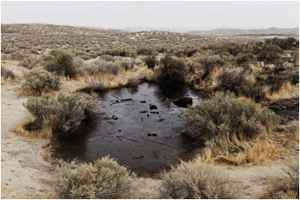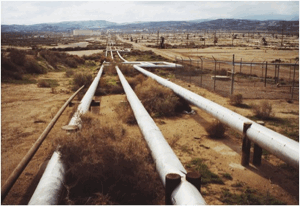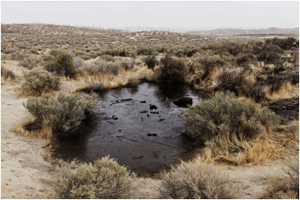Mixing Oil and Water
Air Date: Week of February 11, 2011
A natural oil seep near McKittrick, CA. (Photo: Todd D'Addario)
Tar sands oil from northern Alberta is notoriously dirty and difficult to get out of the ground and refine. But it turns out California has its own thick and dirty oil. As reporter Jeremy Miller tells host Bruce Gellerman, California is using clean, fresh water, turned to steam, to get that petroleum out of the ground.
Transcript
GELLERMAN: The movie “There Will Be Blood” is set in the desert scrubland of southern California, at the turn of the 19th - 20th century. The story is fiction but many of the events in this tale of family, greed, and oil are based on fact.
[SFX: SOUND FROM THE MOVIE “THERE WILL BE BLOOD”:…there’s a whole ocean of oil under our feet…no one can get at it except for me…]
GELLERMAN: Once, petroleum did gush from wells in the desert sands of southern California, but today, what’s left of the ocean of oil in some parts of this arid region is gooey crude. In places it’s so thick it has to be mined - thinned out with steam.
Problem is: this is one of the most water-starved corners of the country.
Reporter Jeremy Miller traveled to southwestern San Joaquin Valley. His article “The Colonization of Kern County: a story of oil and water” appears in the latest issue of Orion Magazine.
MILLER: When you are driving around, there is oil literally bubbling up from the ground in places if you know where to look. It’s typical, kind of desert, arid, southwest San Joaquin Valley kind of area.
Yeah, it’s a landscape of oil, for sure. And, it’s interesting because it butts up right against all of the big agricultural regions in the southern San Joaquin Valley.

A natural oil seep near McKittrick, CA. (Photo: Todd D'Addario)
GELLERMAN: But the type of oil they’re extracting now is not this gusher oil, it’s more this thick, heavy stuff.
MILLER: It is, yes. One oil driller that I talked to there described it as the consistency of ‘liver in a meat case.’ It’s very thick, gooey, molasses-y, kind of oil. And, that’s a result of the oil sitting in shallow deposits underground and being exposed to air and bacteria– and these bacteria like to chomp on the oil and through that process, the oil gets broken down from the nice stuff that flows like syrup to this sort of semi-solid material.
GELLERMAN: But to extract this type of oil, they have to use prodigious amounts of water - in the form of steam.
MILLER: They do. Yeah, water was a key to unlocking the heavy oil deposits of Kern County. So they’re taking this relatively clean water out of the California aqueduct, and putting it through co-generation plants, which create steam. And they pump it underground, and they use that steam to extract oil. And since that method, called steam flooding, was pioneered back in the 1960’s, most of the oil fields in that area have transferred over to this mode of oil production.
GELLERMAN: So where are they getting all of this water that they use for extracting the oil?

Steam pipes in the Cymric oil field, Kern County, CA. (Photo: Todd D'Addario)
MILLER: So that’s a very good question, and that’s at the heart of my reporting. What I found is that a good portion of the water that oil companies use for steam flooding is coming from the state water project. The state water project administers the California Aqueduct, which is this vast concrete river of water that brings water from the Sacramento, San Joaquin Bay Delta outside of San Francisco, down, all the way to Los Angeles.
So this is not only bringing water to irrigate farms in the central valley, but also bringing drinking water to Los Angeles, Bakersfield, and the other large municipalities in the central valley. So I thought, well, could it be possible that some of this water is coming through the state water project?
And I called Kern County Water Agency, one of the big water distributors in the state - in fact in the world - they are in command of about a million acre-feet of water. I called the water district that serves the main part of the oil fields - it’s the West Kern Water District - and asked the director, JD Bramlet, "Are the oil companies taking water from the state water project through the West Kern Water District to do steam flooding?"
And he told me, "Yeah, they get most of it." And I said, "Well when you say most of it, how much?" And he said, "About 83 percent of the West Kern Water District’s water," which is about 31,000 acre-feet. So, in this parched, dry region, about 83 percent of the water being delivered through the California aqueduct, through one water district alone, is being given to oil companies for steam-flooding operations.
GELLERMAN: So they’re using clean drinking water to extract oil from tar sands?
MILLER: They are, yeah. One of the hiccups of steam flooding, if you will, is that they can’t just use any water to do it. It’s sort of like your coffee maker. If you use dirty water in your coffee maker, you’re going to get stuff precipitating out onto the heating elements of your coffee makers. So the oil companies need a clean, fresh source of water.
One shocking thing that I found in my research is that back in 1985 when oil was at its peak in California, in Kern County it took about four and a half barrels of water to generate one barrel of oil. Okay, four and a half barrels of fresh water to generate one barrel of oil. Well, that oil field is in decline now. Today it takes close to eight barrels of water to generate one barrel of heavy oil. It’s enough water to supply 200,000 households, or about 500,000 people, for a year.
GELLERMAN: From reading your article, this is an area where the aqueduct carrying clean drinking water goes right past towns that don’t have clean drinking water.
MILLER: Exactly. There are dozens of small towns within sight of the aqueduct, as you say, that don’t have access to clean drinking water. So that water flows right past to the oil fields and these towns are forced to deal with well water that they have, which in a lot of cases is contaminated with agricultural pollutants and other natural pollutants.
Yeah, it’s a landscape that’s defined by drought. It’s a semi-arid desert. I mean, this is an area, where, like you say, every drop of water counts.
GELLERMAN: You know, it’s really disturbing to read and think that our addiction to oil, or our need for oil, is so great that we would use water - water that’s scarce - to extract oil from the ground.
MILLER: Yeah, it’s shocking. There’s no other way to put it. And when you’re driving in the area, when you’re walking around in these dry hill sides, it really comes into focus - when you realize that all those miles worth of silver pipes are carrying a vast amount of super-heated steam to get this oil up out of the ground.
GELLERMAN: Well, Jeremy Miller, thanks a lot, I really appreciate it.
MILLER: Thank you so much. I appreciate it.
GELLERMAN: Jeremy Miller’s report, “The Colonization of Kern County: a story of oil and water,” appears in the latest edition of Orion magazine.
Links
Jeremy Miller story in Orion magazine
EPA page on Crude Oil and Gas Special Wastes
Industry group The Produced Water Society
US Fish & Wildlife photos: Hazards to wildlife from oil discharge ponds
Argonne National Labs paper on Produced Water in the U.S.
Halliburton link on Composition of Heavy Oil
West Kern Oil Museum for info on the region's history
California Division of Oil, Gas, and Geothermal stats on oil and gas
Living on Earth wants to hear from you!
Living on Earth
62 Calef Highway, Suite 212
Lee, NH 03861
Telephone: 617-287-4121
E-mail: comments@loe.org
Newsletter [Click here]
Donate to Living on Earth!
Living on Earth is an independent media program and relies entirely on contributions from listeners and institutions supporting public service. Please donate now to preserve an independent environmental voice.
NewsletterLiving on Earth offers a weekly delivery of the show's rundown to your mailbox. Sign up for our newsletter today!
 Sailors For The Sea: Be the change you want to sea.
Sailors For The Sea: Be the change you want to sea.
 The Grantham Foundation for the Protection of the Environment: Committed to protecting and improving the health of the global environment.
The Grantham Foundation for the Protection of the Environment: Committed to protecting and improving the health of the global environment.
 Contribute to Living on Earth and receive, as our gift to you, an archival print of one of Mark Seth Lender's extraordinary wildlife photographs. Follow the link to see Mark's current collection of photographs.
Contribute to Living on Earth and receive, as our gift to you, an archival print of one of Mark Seth Lender's extraordinary wildlife photographs. Follow the link to see Mark's current collection of photographs.
 Buy a signed copy of Mark Seth Lender's book Smeagull the Seagull & support Living on Earth
Buy a signed copy of Mark Seth Lender's book Smeagull the Seagull & support Living on Earth


